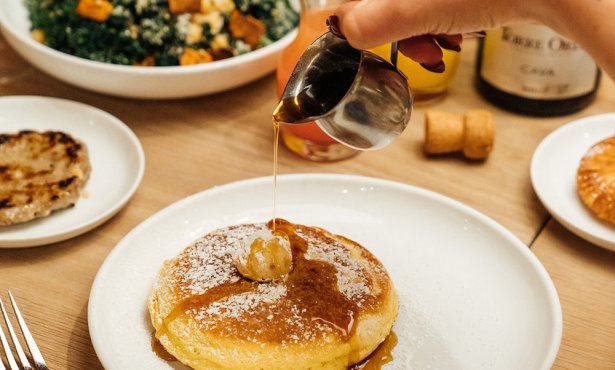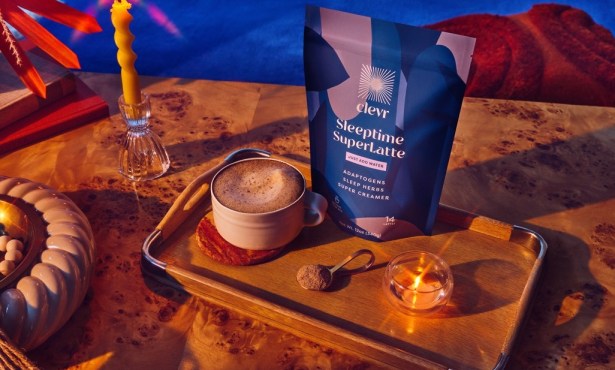Wine of a Good Time
Syrah Symposium in Buellton
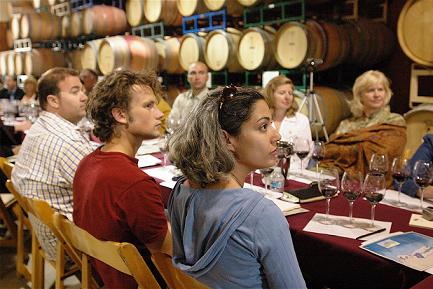
Finely furnished wood, crystal glasses, beautiful hotels, soft silken bedware, white tablecloths, admirable automobiles, valet parking, grand vocabulary, charts and graphs of market trends, obedient servers and banquets of very rustic food: These are just a few of the things that those in the wine trade are accustomed to.
I was given a taste of this dignified world in early May in Buellton, courtesy of five Central Coast vineyards, who hosted 40 members of the wine industry for a Syrah Symposium. The goal of the two-night, one-full-day learning experience was to illuminate Syrah’s noble characteristics and educate those attending on the grape’s origin, history, inferiorities, and virtues.
We checked into the Santa Ynez Valley Marriott Hotel on May 1. I loaded my belongings into my room, and then went for an afternoon bicycle ride. I negotiated the heavy winds common to this region, pedaled 20 miles of road, and at one point found myself suddenly looking west on Highway 246 from the exact point of view of those two guys in that movie, after they left that restaurant called the, oh, Parking Meter, or something. You know the film. Winemakers are loath to even say the name anymore, except those who promote Pinot Noir. Let’s call the film “Lengthwise.”
That evening the guests for the Symposium met in the hotel lobby before herding themselves out to a shuttle bus and into several big shiny cars. From there our caravan drove off to the Santa Ynez Valley Historical Museum and Carriage House for a casual stand-around dinner in the courtyard of the old rustic homestead. The meal was of Mediterranean things, like fig-and-olive salad, grilled vegetables, sun-dried tomatoes, and sauteed mushrooms, and hunks of fine meat.
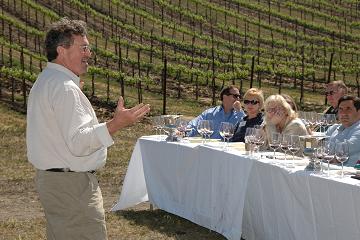
The next morning at breakfast at the Marriott, the Symposium began in full force. Over our servings of fruit, sausage, bacon, fried potatoes, eggs, pastries, and coffee we listened to Peter Neptune, Master Sommelier with the Henry Wine Group, give his thoughts on Syrah. Syrah, he said, has not always been respected as a serious grape and only recently have things begun to change. “We feel that Syrah is a noble varietal,” he announced.
But can Syrah become the next Pinot Noir, Neptune asked us? In fact, Pinot Noir would be discussed at length in the course of the day, suggesting a sense of competition or jealousy between its producers and those of other varietals. Pinot, of course, received a healthy shot of hormones with the release of Lengthwise, and Syrah is now living in the dark shadow of the Pinot Noir grape-but it’s climbing fast to its own level of repute.
“In the mid 1980s you couldn’t give away Syrah for the most part,” said Neptune. Now it’s selling like wildfire and production has increased from 586 tons of Syrah grapes in 1990 to 147,312 tons stomped in 2005. The problem is, said Neptune, the American public still associates Syrah with $4.99 to $9.99 bottles of wine. This price range is cheap and suggests inferior wine. It’s very simple.
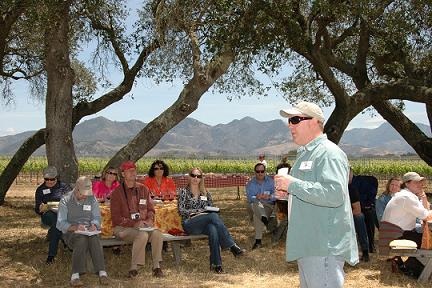
Syrah came to California in the 1970s, and our group, as it turns out, visited the site of the oldest Syrah vineyard in the state, planted in 1979 at Zaca Mesa Vineyard. After admiring the thick trunks and the baby springtime grapes, we had lunch at an outdoor setting amidst some oak trees. In the wine industry, it’s popular for things to be rustic, as it connotes the countryside and the earth from which wine ultimately comes. But things should not be too rustic in the world of fine wine, and we enjoyed white tablecloths to protect our skins from the splintery wood of the old picnic tables. I sat by Peter Neptune, who told me about grape yields tremendously decreasing with a vine’s age and how to properly graft a grapevine and different methods of vine trimming.
The shuttle bus delivered us from one location to the next. At each site were tables dressed in fine white cloths and set with hundreds of beautiful glasses of crimson Syrah, which filtered the sunlight into beautiful red starlight patterns on the table. During a lecture by Kerry Damskey, proprietor of Palmeri Wines, a troop of hunched-over figures meandered into view on a grape-stricken hillside in the distance. These were the worker bees, tending to the vines and making sure our glasses stay filled. Bless them, for it looked like tedious work, moving from plant to plant and examining the leaves and enduring the hot sun. I wondered if their lunchtime banquet would include a tablecloth as white as ours.
From Steve Beckmen we learned about biodynamic farming. This practice involves reading many books and knowing keenly of the stars and the constellations and harboring an unfaltering belief in New Age subtleties. For instance, Beckmen explained to us about burying manure within a cow horn in order to generate a beneficial microbe to be sprayed at a later date over the vines at a rate of one ounce per acre, and this tiny treatment works wonders. (Antlers do not work, Beckmen said, because they are not as proficient at conducting life energies from the cosmos as are cow horns. Also, they’re not hollow.)
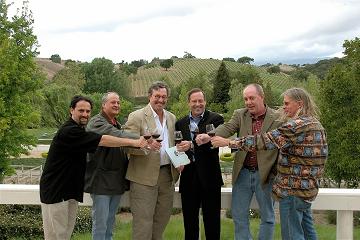
At further discussions throughout the day we sipped more wine, and we learned about rootstock and clonal selections and fun vineyard combinations. At lectures on such subjects the vernacular includes terms like Teleki 5C, Kober 5BB, Clone 877, Clone 470, and the 3309C hybrid. “Leave it to the French,” said Clay Brock of Zaca Mesa Winery. “They have a Romance language, yet they come up with all these sexy names.”
We had an hour break back at the hotel at 3 p.m. before departing for another discussion and dinner at Bridlewood Winery. I rode my bicycle there and I beat the busload by 30 minutes. David Hopkins, the winery’s owner, told us in an old barn full of barrels about blending and grape selection and the advantage of owning numerous vineyards in a swath of land between Santa Barbara County and San Francisco Bay. Hopkins utilizes grapes from this 400-mile swath and spends a great deal of time on the road, and he manages to fit in plenty of surfing as he checks in on his vines and tastes the developing berries. I mean grapes. David allows that good grapes create good wine, but he believes that 70 percent of a wine’s measure of quality is imparted through the fermenting, barreling, and blending processes.
A brief reception with hors d’oeuvres and wine tasting in an old, rustic barn of a gift shop was followed by a catered dinner in another large barn. Four rustic courses would arrive, as would 10 or so wines. The dinner (served on a tablecloth white as snow) evoked all things delicate and fine while the old wooden surroundings evoked the rural, rough country life that winemakers dabble their fingers in. Meanwhile, a microphoned discussion between the Symposium’s winemakers, moderated by Sommelier Neptune, focused largely on the future of Syrah. “Will Syrah become the next Pinot?” asked Neptune. “Will it stand up in the wake of the movie [Lenghthwise]?” “Is the American public confused by high-end Syrah?”
I was still confused at the idea of a $10 bottle being something to spit upon. Kerry Damskey took the microphone and said he predicted that Syrah will be over-planted in the next decade and that it may eventually become an average wine. Well, I thought, at least we’ll all be able to enjoy it.
I rode my bike back to the hotel in the dark. The winemakers and guests passed me on the way back to bed in their comfortable vehicles, and I received a few honks of encouragement. The moon came up behind me and lit my way while the evening breeze came directly into my face. I moved slowly along the road’s shoulder and on the wind I could smell in the distance a surplus of maturing vines and over-planted, average Syrah. You know, it really didn’t smell so bad.

